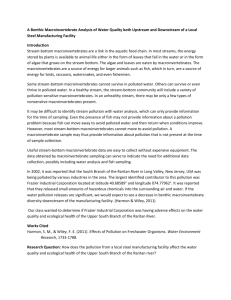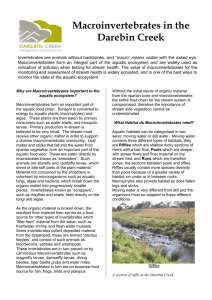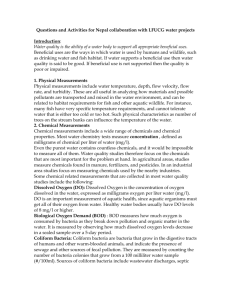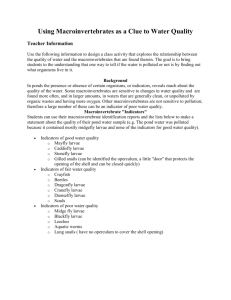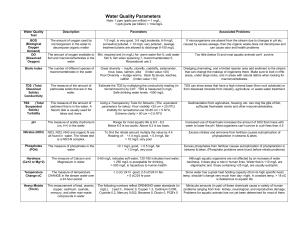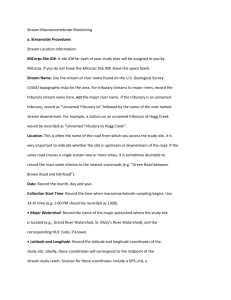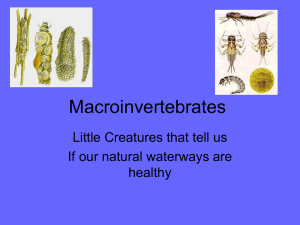LCHS LIBRARY PATHFINDER SOS Stream Study
advertisement
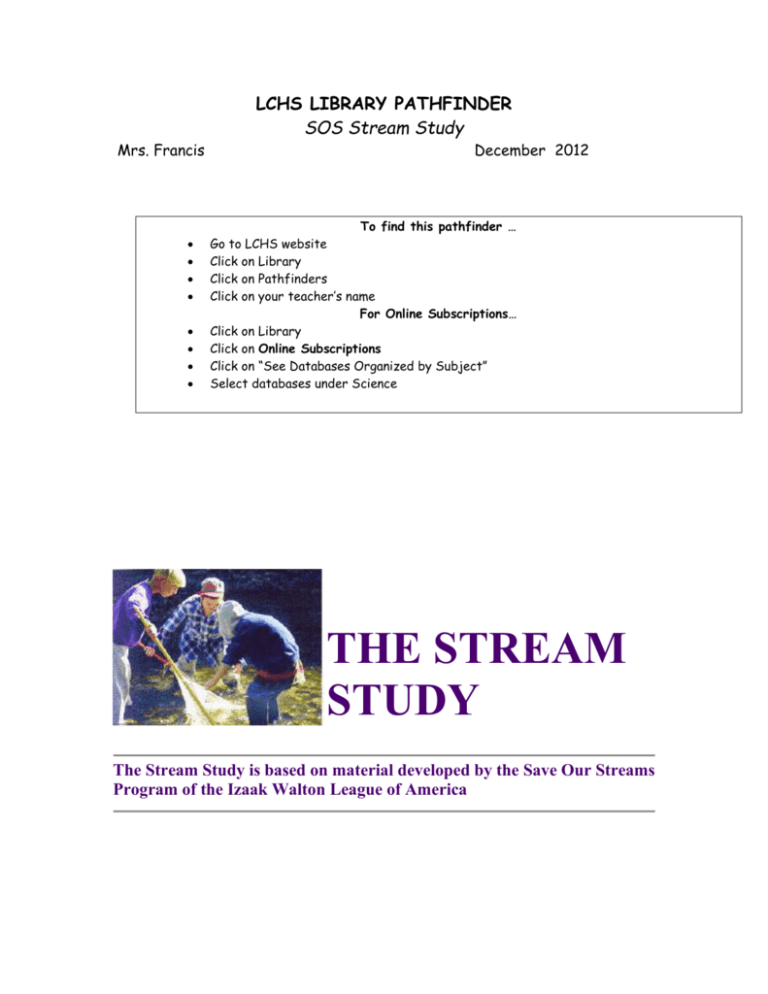
LCHS LIBRARY PATHFINDER SOS Stream Study Mrs. Francis December 2012 To find this pathfinder … Go to LCHS website Click on Library Click on Pathfinders Click on your teacher’s name For Online Subscriptions… Click on Library Click on Online Subscriptions Click on “See Databases Organized by Subject” Select databases under Science THE STREAM STUDY The Stream Study is based on material developed by the Save Our Streams Program of the Izaak Walton League of America The Stream Study provides a method to determine the water quality of a stream based on the collection and identification of stream-bottom macroinvertebrates. Macroinvertebrates are animals that have no backbone and are visible without magnification. Stream-bottom macroinvertebrates include such animals as crayfish, mussels, aquatic snails, aquatic worms, and the larvae of aquatic insects. Table of Contents 1. Why study the stream-bottom macroinvertebrates? 2. Identification of stream-bottom macroinvertebrates. o IDENTIFICATION KEY for common stream-bottom macroinvertebrates. o Catalog of common stream-bottom macroinvertebrates. Macroinvertebrates that are very sensitive to pollution. Macroinvertebrates that are somewhat sensitive to pollution. Macroinvertebrates that are tolerant of pollution. 3. Collection and interpretation of data. Sampling materials and equipment. Sample collection procedures. The Sample Record and Assessment Form. 4. Glossary of terms used in the Stream Study. 5. Additional information sources. (Includes credits for content and graphic material) 6. The Stream Study development team. 7. The Save Our Streams Program. Stream Study Website Manager: Rick Webb, Department of Environmental Sciences, University of Virginia, Charlottesville, VA 22903 (804-924-7817; rwebb@virginia.edu). March 1, 1999 Key Directions This key consists of pairs of opposite choices or descriptive statements. To use this key, start at the first page and read the two statements. Decide which statement best describes the organism and click on your choice. This will take you to the next pair of statements. Repeat the procedure until the macroinvertebrate is identified. You can then click on the macroinvertebrate name and additional information concerning the identification, life history, and pollution sensitivity of the macroinvertebrate will be provided. If you reach a point in the selection of descriptive statements at which neither of the statements apply, you can work your way back through the preceding pairs of statements and perhaps reconsider the choices. In some cases, the additional information about the individual macroinvertebrates will be helpful. In others, you will find that you are unable to identify the particular macroinvertebrate and you will have to identifiy it as "unknown" unless you can find an aquatic biologist or more information to help you with the identification. Some macroinvertebrates (such as some caddisfly larva) will be found in a protective case of sand, small sticks, or other material. You may find it necessary to remove these cases in order to make an identification. For some specimens, magnification with a hand lens will be needed to see the identification characteristics. After you have made an identification you can return to the first page of the key to identify additional specimens. Note: drawings in the key are not to scale. Go to first page of key. Sample Record and Assessment Form Use the print option provided by your web browser to obtain copies of the Sample Record and Assessment Form. The Sample Record and Assessment Form provides a means for gathering and recording sample data and applying this data to make an assessment of stream-water quality. If a stream site is selected for long-term monitoring, the completed forms will provide documentation of changes in water quality that may occur over time. The Sample Record and Assessment Form provides space for identifying the stream that is sampled, the specific location on the stream where the sample is collected, the date of sample collection, and the names of the sample collectors. The form also provides for recording general stream conditions at the time of sampling, including stream-water temperature and descriptions of stream-flow level and stream clarity. The results of macroinvertebrate sampling should be recorded on the form by checking the box and entering the number of specimens collected for each of the listed macroinvertebrate types. The water quality rating for the sample site is then calculated based on an index value that is determined by the number of macroinvertebrate types collected. The index value is calculated by multiplying 3 times the number of sensitive types, 2 times number of somewhat sensitive types, and 1 times the number of tolerant (nonsensitive) types. The three resulting values are then summed to provide a total index value which is compared to the values for excellent, good, fair, and poor water quality ratings. The index values and water quality ratings are based on the number of different kinds of macroinvertebrates collected, rather than the number of individual specimens collected. Good water quality is indicated by a variety of different kinds of macroinvertebrates. Poor water quality may be indicated by large numbers of only a few kinds of macroinvertebrates. Note that the methods established for the Save Our Streams Program call for collecting samples at 3 separate locations at a site and only recording the data for the sample with the best water quality rating. This provides a more reliable assessment for the site. THE STREAM STUDY The Stream Study is based on material developed by the Save Our Streams Program of the Izaak Walton League of America The Stream Study provides a method to determine the water quality of a stream based on the collection and identification of stream-bottom macroinvertebrates. Macroinvertebrates are animals that have no backbone and are visible without magnification. Stream-bottom macroinvertebrates include such animals as crayfish, mussels, aquatic snails, aquatic worms, and the larvae of aquatic insects. What are freshwater macro-invertebrates? Freshwater benthic macroinvertebrates, or more simply "benthos", are animals without backbones that are larger than ½ millimeter (the size of a pencil dot). These animals live on rocks, logs, sediment, debris and aquatic plants during some period in their life. The benthos include crustaceans such as crayfish, mollusks such as clams and snails, aquatic worms and the immature forms of aquatic insects such as stonefly and mayfly nymphs. Where and when are freshwater benthic macroinvertebrates found? These animals are widespread in their distribution and can live on all bottom types, even on manmade objects. They can be found in hot springs, small ponds and large lakes. Some are even found in the soil beneath puddles. Many species of benthos are able to move around and expand their distribution by drifting with currents to a new location during the aquatic phase of their life or by flying to a new stream during their terrestrial phase. Most benthic species can be found throughout the year, but the largest numbers occur in the spring just before the reproductive period. In colder months, many species burrow deep within the mud or remain inactive on rock surfaces. Many aquatic insects undergo a complete metamorphosis - the transition from egg to larva to pupa and finally to adult. They remain in the water for most of their lives (typically one month to four years). After becoming adults, the majority of insects live for only a brief time, usually a few hours to a few days, while they locate mates and reproduce. What is the ecological importance of benthic macroinvertebrates? Benthos is an important part of the food chain, especially for fish. Many invertebrates feed on algae and bacteria, which are on the lower end of the food chain. Some shred and eat leaves and other organic matter that enters the water. Because of their abundance and position as “middlemen” in the aquatic food chain, benthos plays a critical role in the natural flow of energy and nutrients. As benthic invertebrates die, they decay, leaving behind nutrients that are reused by aquatic plants and other animals in the food chain What are the advantages of using the benthos to monitor water quality? Unlike fish, benthos cannot move around much so they are less able to escape the effects of sediment and other pollutants that diminish water quality. Therefore, benthos can give us reliable information on stream and lake water quality. Their long life cycles allow studies conducted by aquatic ecologists to determine any decline in environmental quality. Benthos represents an extremely diverse group of aquatic animals, and the large number of species possess a wide range of responses to stressors such as organic pollutants, sediments, and toxicants. Many benthic macroinvertebrates are long-lived, allowing detection of past pollution events such as pesticide spills and illegal dumping. How are the benthos sampled and analyzed? Sampling is based on the type of aquatic habitat under study. In turbulent riffles (shallow areas with fast flows), the most commonly sampled stream habitat, various nets are used to capture benthos. The nets are secured and the water is stirred up causing the benthos to float down stream into the net. In slow moving or still water, a dip net is often used to sample shore areas under bank overhangs or tree roots. In ponds or lakes with soft mud bottoms, grab samplers may be used to collect benthos. Benthic communities can be used to monitor stream quality conditions over a broad area or they can be used to determine the effects of point source discharges from sources such as sewage treatment plants and factories. Ecologists who evaluate environmental quality using the benthos often consider the following characteristics of a benthic sample to be important indicators of stream, river or lake quality: 1. Taxa richness: a measure of the number of different types of animals; greater taxa richness generally indicates better water quality. 2. Pollution tolerance: many types of benthos are sensitive to pollutants such as metals and organic wastes. Mayflies, stoneflies, and caddisflies are generally intolerant of pollution. If a large number of these insect types are collected in a sample, the water quality in the stream is likely to be good. If only pollutiontolerant organisms such as non-biting midges and worms are found, the water is likely to be polluted. 3. Functional groups: the presence or absences of certain feeding groups (such as scrapers and filterers) may indicate a disturbance in the food supply of the benthic animals in the stream and the possible effects of toxic chemicals. When water quality, habitat condition, land use and fish are evaluated along with benthos, the result is a comprehensive picture of environmental quality. This information helps resource managers at DNR to determine which rivers and streams in Maryland have good habitat quality and should be protected. The benthos can also help identify those rivers and stream showing signs of stress. Resource managers can then apply management actions that will improve environmental quality, such as storm water control in urban areas and best management practices on farmlands to control nutrient runoff. Each year, ecologists in DNR's Resource Assessment Service monitor freshwater benthos at more than 250 randomly-selected small to medium-sized streams as part of the nationally-recognized Maryland Biological Stream Survey (MBSS). On larger rivers, 116 sites have been sampled annually or biennially since 1974. http://www.dnr.maryland.gov/streams/mbss/mbss_volun.html Sample Stream 1 (1) 10 collected (1) 8 collected (1) 4 collected (1) 2 collected (1) 6 collected (1) 2 collected (1) 4 collected (1) 2 collected (1) 12 collected (1) 1 collected Sample Stream 2 (2) 2 collected (2) 3 collected (2) 1 collected (2) 1 collected (2) 2 collected (2) 14 collected (2) 2 collected (2) 4 collected Sample Stream 3 (3) 2 collected (3) 2 collected (3) 4 collected (3) 5 collected (3) 3 collected (3) 3 collected Sample Stream 4 (4) 2 collected (4) 2 collected (4) 4 collected (4) 5 collected (4) 3 collected (4) 12 collected Sample Stream 5 (5) 15 collected (5) 3 collected (5) 9 collected (5) 20 collected Sample Stream 6 (6) 7 collected (6) 2 collected (6) 8 collected (6) 1 collected (6) 4 collected (6) 10 collected (6) 2 collected (6) 2 collected (6) 2 collected (6) 2 collected
